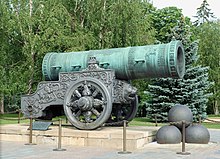Tsar Cannon
| Царь-пушка | |

A view of the Tsar Cannon, showing its massive bore and the Lion's head cast into the carriage.
|
|
| Coordinates | 55°45′04″N 37°37′05″E / 55.75111°N 37.61806°ECoordinates: 55°45′04″N 37°37′05″E / 55.75111°N 37.61806°E |
|---|---|
| Location | Moscow, Russia |
| Designer | Andrey Chokhov |
| Type | Cannon |
| Material | Bronze |
| Length | 5.94 metres (19.5 ft) |
| Completion date | 1586 |
The Tsar Cannon (Russian: Царь-пушка, Tsar'-pushka) is a large medieval artillery piece (known as a bombarda in Russian) on display on the grounds of the Moscow Kremlin. It is a monument of Russian artillery casting art, cast in bronze in 1586 in Moscow, by the Russian master bronze caster Andrey Chokhov. Mostly of symbolic impact, it was never used in a war. However the cannon bears traces of at least one firing. Per the Guinness Book of Records it is the largest bombard by caliber in the world, and it is a major tourist attraction in the ensemble of the Moscow Kremlin.
The Tsar Cannon is located just past the Kremlin Armory, facing towards the Kremlin Senate. The very low ratio of the length of its barrel to its caliber makes it technically not a cannon, but a stylized mortar. The Tsar Cannon is made of bronze; it weighs 39.312 tonnes and has a length of 5.34 m (17.5 ft). Its bronze-cast barrel has an internal diameter of 890 mm (35.0 in), and an external diameter of 1,200 mm (47.2 in). The barrel has eight cast rectangular brackets for use in transporting the gun, which is mounted on a stylized cast iron gun carriage with three wheels. The barrel is decorated with relief images, including an equestrian image of Tsar Fyodor Ivanovich, with a crown and a scepter in his hand on horseback. Above the front right bracket the message "The grace of God, Tsar and Great Duke Fyodor Ivanovich, Autocrat of all Great Russia" was cast. There were two more labels cast at the top of the barrel, to the right is "The decree of the faithful and Christ-king and the Grand Duke Fyodor Ivanovich, Sovereign Autocrat of all Great Russia with his pious and god-blessed queen, Grand Princess Irina"; While to the one to the left is "Cast in the city of Moscow in the summer of year 7904(c. 1585 in Gregorian calendar), in his third summer state, by Andrey Chokov." The cannon-style gun carriage, added in 1835, is purely decorative. This weapon was never intended to be transported on or fired from this gun carriage.
...
Wikipedia
